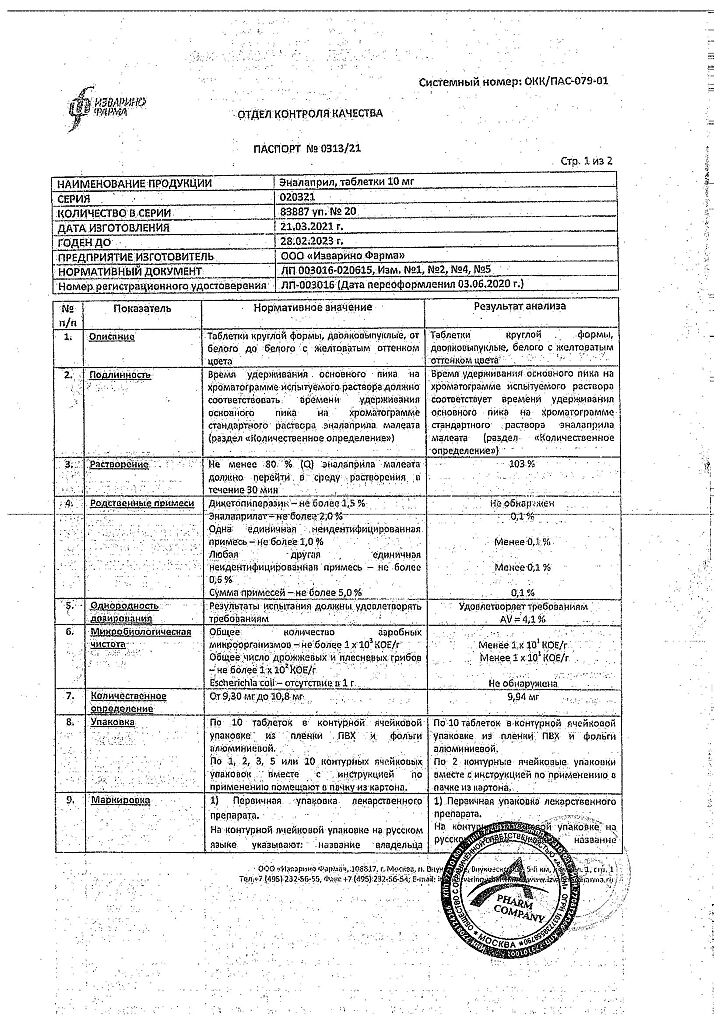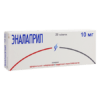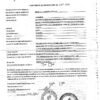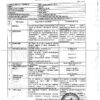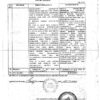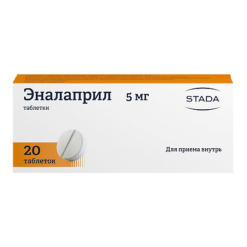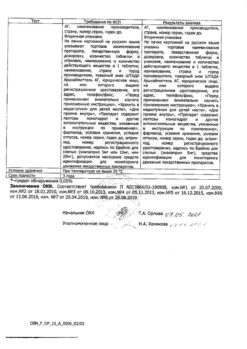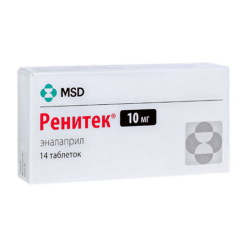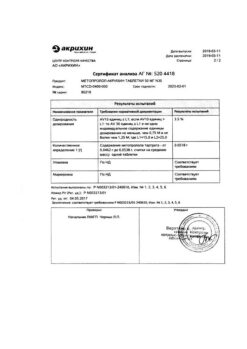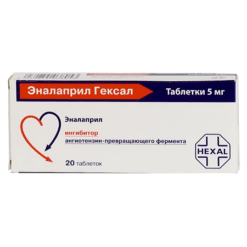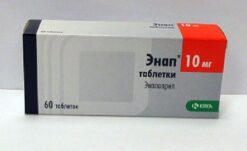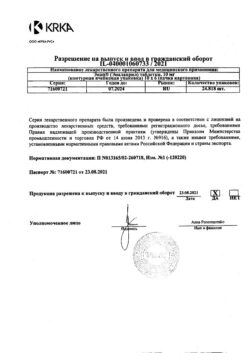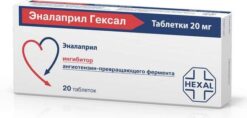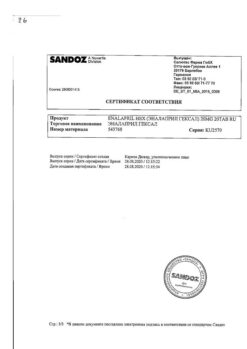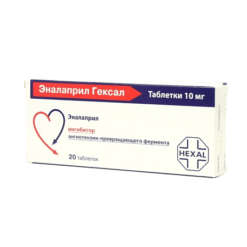No products in the cart.
Enalapril, tablets 10 mg 20 pcs
€2.47 €2.06
Out of stock
(E-mail when Stock is available)
Description
Pharmgroup:
APP inhibitor.
Pharmic action:
The ACE inhibitor is a hypotensive drug and its mechanism of action is related to the reduction of formation from angiotensin I of angiotensin II, a decrease in the concentration of which leads to a direct reduction of aldosterone secretion. This decreases RPS, systolic and diastolic BP, and post- and preload on the myocardium. It dilates the arteries more than the veins, and there is no reflex increase in heart rate. Reduces bradykinin degradation, increases Pg synthesis. Hypotensive effect is more pronounced at high plasma renin concentration than at normal or reduced.
The decrease of BP within therapeutic limits has no effect on the cerebral blood flow, the blood flow in the brain vessels is maintained at a sufficient level even against the background of reduced BP. It enhances coronary and renal blood flow. Long-term use reduces LV myocardial hypertrophy and myofibrillation of arterial walls of the resistive type, prevents the progression of CHF and slows the development of LV dilatation. It improves blood supply of ischemic myocardium.
Limits platelet aggregation. Prolongs survival in patients with CHF and slows the progression of LV dysfunction in patients who had myocardial infarction without clinical manifestations of CHF.
It has some diuretic effect. It reduces intracolumnar hypertension, slowing down the development of glomerulosclerosis and the risk of CKD.
Enalapril is a “prodrug”: as a result of its hydrolysis enalaprilate is formed, which inhibits ACE.
Time of onset of hypotensive effect when taken orally is 1 hour, it reaches a maximum after 4-6 hours and lasts up to 24 hours. In some patients several weeks therapy is necessary to achieve optimal BP level. With CHF, a noticeable clinical effect is observed with long-term treatment of 6 months or more.
Pharmacokinetics:
After oral administration absorption is 60%. Food intake has no effect on absorption. In the liver it is metabolized to form the active metabolite enalaprilat, which is a more effective ACE inhibitor than enalapril. Binding to plasma proteins of enalaprilat is 50-60%. TCmax of enalapril is 1 h, of enalaprilat – 3-4 h.
Enalaprilat easily passes through the histohematic barriers, excluding the BBB, a small amount passes through the placenta and into breast milk.
The T1/2 of enalaprilat is 11 h. It is excreted primarily by the kidneys – 60% (20% as enalapril and 40% as enalaprilat), through the intestine – 33% (6% as enalapril and 27% as enalaprilat).
Eliminated by hemodialysis (rate 62 ml/min) and peritoneal dialysis.
Indications
Indications
Arterial hypertension (symptomatic, renovascular, including. in scleroderma, etc.), CHF of I-III stage;
Prevention of coronary ischemia in patients with LV dysfunction, asymptomatic LV dysfunction.
Active ingredient
Active ingredient
Composition
Composition
Enalapril 10 mg.
How to take, the dosage
How to take, the dosage
Overly, regardless of meals.
In monotherapy of arterial hypertension, the initial dose is 5 mg once daily. If there is no effect, after 1-2 weeks the dose is increased by 5 mg. After the initial dose, patients should be under medical supervision for 2 hours and an additional 1 hour until BP stabilizes. If necessary and tolerated well enough, the dose can be increased to 40 mg/day at 1-2 doses. After 2-3 weeks, switch to a maintenance dose of 10-40 mg/day divided into 1-2 doses. In moderate hypertension, the average daily dose is about 10 mg. The maximum daily dose of the drug is 40 mg.
If prescribed to patients simultaneously receiving diuretics, diuretic treatment should be discontinued 2-3 days before enalapril administration. If this is not possible, the starting dose of enalapril should be 2.5 mg/day.
Patients with hyponatremia (serum Na+ concentration less than 130 mmol/L) or serum creatinine concentration greater than 0.14 mmol/L have a starting dose of 2.5 mg once daily.
Renovascular hypertension: initial dose is 2.5-5 mg/day. The maximum daily dose is 20 mg.
In severe arterial hypertension, IV administration is possible (see Enalaprilat), conducted only in a hospital setting.
In CHF, the initial dose is 2.5 mg once, then the dose is increased by 2.5-5 mg every 3-4 days according to clinical response to the maximum tolerated dose (depending on BP), but no more than 40 mg/day, once, or in 2 doses. In patients with low systolic blood pressure (less than 110 mmHg), therapy should be started with a dose of 1.25 mg. The dose should be adjusted over 2-4 weeks or at shorter intervals. The average maintenance dose is 5 to 20 mg/day with 1 to 2 doses.
A more pronounced hypotensive effect and prolonged duration of action of the drug are more often observed in elderly patients due to decreased elimination rate of enalapril, so the recommended starting dose for elderly patients is 1.25 mg.
In CKD, cumulation occurs when filtration is less than 10 mL/min. For CK 80-30 mL/min, the dose is usually 5-10 mg/day, CK 30-10 mL/min is 2.5-5 mg/day, and less than 10 mL/min is 1.25-2.5 mg/day on dialysis days only.
The duration of treatment depends on the effectiveness of therapy. If BP decreases too significantly, the dose of the drug is gradually reduced.
Interaction
Interaction
Enhances the effect of ethanol, slows excretion of Li+.
Limits the effect of drugs containing theophylline.
Hypotensive effect is decreased by NSAIDs including selective COX-2 inhibitors, estrogens; it is increased by diuretics, other hypotensive drugs (beta-adrenoblockers, methyldopa, nitrates, BMCC, hydralazine, prazosin), drugs for general anesthesia, ethanol.
Potassium-saving diuretics and potassium-containing drugs increase the risk of hyperkalemia.
The drugs causing bone marrow suppression increase the risk of neutropenia and/or agranulocytosis.
In concomitant use of ACE inhibitors and parenteral gold drugs (sodium aurothiomalate) a symptom complex including facial hyperemia, nausea, vomiting and decreased BP has been described.
Simultaneous use with insulin and oral hypoglycemic drugs increases the risk of hypoglycemia.
Immunosuppressants, allopurinol, cytostatics increase hematotoxicity.
Special Instructions
Special Instructions
Caution should be exercised when prescribing to patients with decreased blood pressure (as a result of diuretic therapy, restriction of table salt intake, hemodialysis, diarrhea and vomiting) – the risk of sudden and pronounced BP decrease after using even the initial dose of ACE inhibitor is increased. Transient hypotension is not a contraindication for continuation of treatment with the drug after BP stabilization. In case of repeated pronounced BP decrease, the dose should be reduced or the drug should be discontinued.
In case of development of excessive BP decrease, the patient should be placed in horizontal position with low headrest; if necessary, 0.9% NaCl solution and plasma exchange drugs should be administered.
The use of high-flow dialysis membranes (including AN69) increases the risk of anaphylactic reaction. Adjustment of the dosing regimen on days free of dialysis should be made depending on BP.
Before and during treatment with ACE inhibitors, BP, blood parameters (Hb, concentration of K+, creatinine, urea, activity of “liver” enzymes), urine protein should be controlled.
Patients with decompensated CHF, CHD, and cerebrovascular disease in whom a sharp decrease of BP may result in myocardial infarction, stroke, or impaired renal function should be closely monitored. Sudden discontinuation of treatment does not lead to “withdrawal” syndrome (a sharp rise in BP).
Patients with a history of angioedema have an increased risk of developing it when taking ACE inhibitors.
In newborns and infants who have had intrauterine exposure to ACE inhibitors should be closely monitored for the timely detection of marked BP decline, oliguria, hyperkalemia, and neurologic impairment that may result from decreased renal and cerebral blood flow with ACE inhibitor-induced BP decline. In oliguria, it is necessary to maintain BP and renal perfusion by administration of appropriate fluids and vasoconstrictors.
In patients with reduced renal function, the single dose should be reduced or the intervals between doses should be increased.
Enalapril should be discontinued before parathyroid function tests.
Cautions should be taken when exercising or in hot weather (risk of dehydration and excessive BP decrease due to decreased BOD).
Warn the surgeon/anesthesiologist about the use of ACE inhibitors before surgical procedures (including dentistry).
At the time of treatment, caution should be exercised when driving a vehicle and engaging in other potentially dangerous activities requiring increased concentration and rapid psychomotor reactions (dizziness is possible, especially after taking the initial dose of ACE inhibitor in patients taking diuretic drugs).
Contraindications
Contraindications
Hypersensitivity to enalapril or other ACE inhibitors;
Pregnancy, lactation.
With caution:
Anhyoneurotic edema in the history of therapy with ACE inhibitors, hereditary or idiopathic angioedema;
Aortic stenosis;
Cerebrovascular disease (including.ч. Cerebrovascular failure);
IBS;
Coronary artery disease;
Severe autoimmune systemic connective tissue diseases (includingч. SLE, scleroderma);
Inhibition of medullary hematopoiesis;
Diabetes mellitus;
Hyperkalemia;
Bilateral renal artery stenosis;
Stenosis of the artery of the sole kidney;
Post renal transplant condition;
Renal and/or hepatic insufficiency;
Na+ restricted diet;
Diseases accompanied by decreased BOD (including
Elderly age, age under 18 years (safety and effectiveness not studied).
Side effects
Side effects
Cardiovascular disorders: excessive decrease in BP, orthostatic collapse, rarely – chest pain, angina pectoris, myocardial infarction (usually associated with a pronounced decrease in BP), arrhythmias (atrial bradycardia or tachycardia, atrial fibrillation), palpitation, pulmonary artery thromboembolism.
Nervous system disorders:dizziness, fainting, headache, weakness, insomnia, anxiety, confusion, increased fatigue, somnolence (2-3%), very rarely with high doses – nervousness, depression, paresthesias.
Sensory organs:vestibular disorders, hearing and vision disorders, tinnitus.
From the digestive system: Dry oral mucosa, decreased appetite, dyspeptic disorders (nausea, diarrhea or constipation, vomiting, abdominal pain), intestinal obstruction, pancreatitis, impaired liver function and biliary excretion, hepatitis, jaundice.
In the respiratory system:unproductive “dry” cough, interstitial pneumonitis, bronchospasm, shortness of breath, rhinorrhea, pharyngitis.
Allergic reactions: skin rash, angioedema of the face, small intestine (very rare), extremities, lips, tongue, vocal cleft and/or larynx, dysphonia, exfoliative dermatitis, erythema multiforme exudative erythema (including Stevens-Joint syndrome).Stevens-Johnson syndrome), toxic epidermal necrolysis (Lyell’s syndrome), pemphigus, pruritus, urticaria, photosensitization, serositis, vasculitis, myositis, arthralgia, arthritis, stomatitis, glossitis.
In terms of laboratory parameters: hypercreatininemia, increased concentration of urea, increased activity of “hepatic” transaminases, hyperbilirubinemia, hyperkalemia, hyponatremia, decreased Hb and hematocrit, increased COE, thrombocytopenia, neutropenia, agranulocytosis (in patients with autoimmune diseases), eosinophilia.
Urinary system disorders: renal dysfunction, proteinuria.
Others: alopecia, decreased libido, “rushes” of blood to the face. Cases of hypoglycemia have been reported in patients with diabetes mellitus who were taking insulin and oral hypoglycemic drugs.
Overdose
Overdose
Symptoms: excessive decrease in BP, up to the development of collapse, myocardial infarction, acute stroke or thromboembolic complications; convulsions, stupor.
Treatment: the patient is transferred to a horizontal position with a low headboard. In mild cases gastric lavage and oral administration of saline solution are indicated, in more severe cases – measures aimed at BP stabilization: intravenous infusion of 0.9% NaCl solution, plasma substitutes, if necessary – intravenous angiotensin II, hemodialysis (elimination rate of enalaprilat 62 ml/min).
Similarities
Similarities
Additional information
| Manufacturer | Izvarino Pharma, Russia |
|---|---|
| Medication form | pills |
| Brand | Izvarino Pharma |
Other forms…
Related products
Buy Enalapril, tablets 10 mg 20 pcs with delivery to USA, UK, Europe and over 120 other countries.



